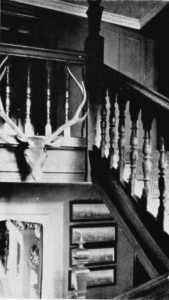Last year British History Online published the complete series of the Royal Commission on Historical Monuments, England. To introduce these volumes for readers who may not be familiar with the RCHME, we asked a number of experts to write introductions to particular counties. Here Charles O’Brien, one of the general editors of the revised Pevsner series from Yale University Press introduces the Huntingdonshire volume. Charles revised the volume Bedfordshire, Huntingdonshire and Peterborough (forthcoming), so is the ideal person to put RCHME, Hunts in context. Charles writes:
Huntingdonshire was one of the smallest counties of England. In 1965 it was merged with the Soke of Peterborough as a new county but both were abolished in 1974 and absorbed into the newly reconstituted county of Cambridgeshire. Huntingdonshire’s identity is preserved as a district within Cambridgeshire but appreciation of local architectural identity is easily lost and so historians should still value the coverage given to it in one of the earliest RCHME inventories, published in 1926.
Nikolaus Pevsner, in his survey of Huntingdonshire for the Buildings of England series (1st ed. 1968) relied heavily on the Commission’s inventory while admitting ‘I am only too well aware of the inadequacies of my gazetteer. Anyone who studies the volume [of the RCHM] can see for himself how many timber-framed houses, how many staircases, how many domestic fitments are left, and guess from that how much more is missing for the C18 which the Royal Commission at the time …did not include’. Pevsner’s copy of the volume remains in the Pevsner Architectural Guides office at Yale University Press, and throughout the volume are his minute annotations and strikings out, indicating that the RCHME volume was in his hands as he carried out his visits during the spring of 1967.
A notable contribution to the Hutingdonshire volume was provided by Sidney Inskip Ladds (1867-1950), architect and local historian who became one of the authors for the three volumes of the Victoria History of the Counties of England (1926-1936). Ladds came from a local family, his grandfather was rector of Ellington, one of the many stone churches with a tall Perp spire for which Huntingdonshire is, or should be, well-known, and his father John Ladds was also an architect, with a modest living from church restorations in the later years of his life, an area of practise which would dominate Sidney’s working life. Partly as a consequence of his church work Ladds accumulated a very considerable body of knowledge of Huntingdonshire’s buildings and his voluminous files of scraps of paper recording his observations, names of architects, genealogy, recollections of incumbents and others are lodged at the Norris Museum, St Ives. Much of his close interest in buildings of every period is reflected in the coverage of the VCH volumes and clearly expressed in the RCHME inventory.
At least part of the pleasure to be taken from the RCHME volumes of the earlier period is in making comparisons between the photographs with the present day, especially the village scenes with their car-less and thus immensely spacious streets but also in the general character of the vernacular buildings of the locality many of which have been significantly altered since the early C20, if not demolished. Others are pleasantly unchanged (the interior of the Lion Hotel, Buckden of c.1500 is an example) and for churches and major houses there is little to record in the way of loss. Only a small proportion of the county’s buildings recorded by photos in the volume have disappeared, notably Conington Castle, but among the timber-framed buildings there had even by the 1960s been a higher rate of attrition and one will search in vain for some of the houses recorded in the plates section of the volume or at least deplore the often insensitive restoration to which they were later subjected, e.g. a seventeenth-century house at Offord Cluny (plate 102) which is now hardly recognisable.

